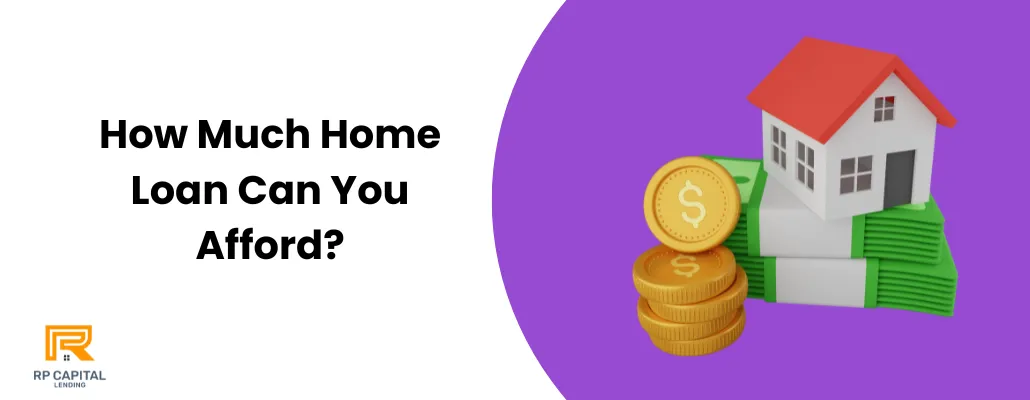Blog

How Much Home Loan Can You Actually Afford?
Buying a home is exciting… but figuring out how much home loan you can actually afford can feel like a maze of numbers, ratios, and confusing terms. Don’t worry we’re breaking it down in simple, human language so you can make a confident decision before jumping in.
Whether you're a first-time buyer or upgrading your lifestyle, understanding loan affordability is the smartest first step before applying for financing with RP Capital Lending.
Why Loan Affordability Matters
Before a lender decides your loan amount, they look at one thing first: your ability to repay.
But it’s not just what the lender allows it’s about what you can comfortably handle each month without feeling stretched.
A home should bring peace, not pressure.
Key Factors That Decide How Much Home Loan You Can Afford
1. Your Monthly Income (Your Starting Point)
Lenders check your gross monthly income to see how much of it can safely go toward housing costs.
Most lenders follow the 28/36 rule:
28% of your income can go to mortgage expenses
36% of your income can go to total debt (including car loans, credit cards, etc.)
Example
If you earn $8,000/month:
28% for mortgage = $2,240/month
36% for all debt = $2,880/month
So, your mortgage payment should not exceed $2,240 unless your other debts are extremely low.
2. Your Existing Monthly Debts
Car loan? Credit cards? Student loan?
These reduce the amount you can safely borrow.
Debt-to-Income (DTI) Ratio
DTI = (Total monthly debt payments ÷ Gross monthly income) × 100
Most lenders prefer DTI under 43%, but stronger profiles can get approved with slightly higher ratios.
3. Your Down Payment
A bigger down payment = a more affordable loan + lower monthly payments.
Typical down payment ranges:
3% to 20% (depending on credit, loan type, property)
Down Payment Impact Example
*Approx. estimates. Rates vary based on credit, loan program & market conditions.
4. Your Credit Score
A higher credit score gives you:
Lower interest rates
Lower monthly payments
Higher loan approval chances
Quick insight: A difference of just 0.5% in interest rate can save you tens of thousands over the loan term.
5. The Loan Term You Choose
Common home loan terms:
30-year fixed → lowest monthly payments
15-year fixed → higher payments but huge interest savings
Choose based on your long-term comfort, not just what a calculator says.
6. Interest Rate Environment
Market conditions can change your affordability overnight.
Higher interest rate = higher monthly payment
Lower interest rate = more borrowing power
Example:
A $400,000 loan at 6.5% vs 7.5% changes your monthly payment by over $300/month.
A Practical Method to Calculate Your Safe Loan Amount
Here’s a simple formula you can use:
Step 1:
Calculate 28% of your gross monthly income.
Step 2:
Subtract all monthly debt payments from 36% of your income.
Step 3:
Whichever number is lower = your safe monthly mortgage budget.
Step 4:
Use that number to estimate your max loan:
Loan amount ≈ Mortgage Payment ÷ Interest Factor
Example with $8,000 income and $400 debt:
36% of $8,000 = $2,880
$2,880 – $400 = $2,480
28% rule gives $2,240
Safe number = $2,240/month
At 7% interest → ~$335 payment per $50,000 borrowed
$2,240 ÷ $335 ≈ $335,000 loan amount
Signs You’re Choosing a Loan You Can’t Afford
Watch out for these red flags:
Your savings will be wiped out after the down payment
Your payment relies on overtime/bonuses
You would struggle to cover unexpected expenses
Your DTI is already high
You’re choosing a loan based only on what the lender approves
Remember: lenders approve what’s safe for them, not necessarily what’s comfortable for you.
Tips to Improve Your Loan Affordability
Increase your down payment
Pay off high-interest debt
Improve your credit score
Choose a lower-priced home
Compare loan types (Conventional, FHA, DSCR, Bank Statement Loans, etc.)
Shop for better interest rates
If you're a business owner or investor, RP Capital Lending also offers alternative documentation loans that expand your approval options.
Conclusion
Determining how much home loan you can truly afford is a mix of smart math, financial awareness, and honest self-assessment. When you understand the numbers behind affordability, you make better choices, avoid stress, and secure a home that fits your lifestyle — not one that strains it.
Ready to find out exactly how much you qualify for?
RP Capital Lending can help you calculate it, compare loan options, and secure the best financing for your goals.
👉 Contact us today for a personalized affordability analysis.
FAQs
1. How is home loan affordability calculated?
Lenders use your income, debts, credit score, down payment, employment history, and the 28/36 DTI rule to estimate how much you can safely borrow.
2. What credit score do I need for a home loan?
A score of 620+ is ideal for conventional loans, but FHA programs allow lower scores. Higher scores mean better interest rates.
3. Does a bigger down payment help me qualify for more?
Yes — it reduces the loan amount, lowers monthly payments, and can help you clear lender limits more easily.
4. Can self-employed individuals get accurate affordability estimates?
Absolutely. With programs like bank statement loans and DSCR investment loans, self-employed borrowers can qualify based on cash flow, not traditional income paperwork.
5. How do interest rates affect how much loan I can afford?
Higher rates = higher monthly payments = lower loan eligibility
Lower rates = more purchasing power
RP Capital Lending is a d.b.a of RP Capital Partners Inc (NMLS # 2469193) | Privacy Policy
Copyright © 2022. All Rights Reserved.
Disclaimer: Loans only apply to non-owner occupied properties. Rates, terms and conditions offered only to qualified borrowers, may vary upon loan product, deal structure, other applicable considerations, and are subject to change at any time without notice.

